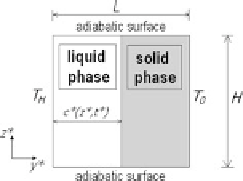Information Technology Reference
In-Depth Information
Fig. 12.1 Physical problem
at time t* = 0
Based on the previous hypothesis, the governing equations used in the non-
rectangular liquid domain can be written in their dimensionless form as following:
r
V ¼ 0
ð
12
:
3
Þ
q
ð
T
Þ
q
ref
q
ref
k
gH
3
t
2
ð
V
rÞ
V ¼
r
2
V
r
P+
ð
12
:
4
Þ
Pr
r
2
h
( V
rÞ
h ¼
1
ð
12
:
5
Þ
The dimensionless velocity vector V is given by: V ¼ V
ð Þ=
t, where t is the
kinematic viscosity. The dimensionless temperature is given by h ¼ T
T
av
ð Þ=
DT ,
where T
av
is the average temperature given by T
av
¼ T
H
þ
T
Fu
ð Þ=
2. T is the
dimensional temperature, and DT ¼ T
H
T
Fus
. The Prandtl number is given by
Pr = t/a, and a is the thermal diffusivity. P is the dimensionless pressure, given by
P ¼ P
ðÞ
H
2
; q
ref
is the reference density (equal to the average density of the
interval imposed by the temperature of the walls) and k is the unitary vector in the
vertical direction. At the moving interface, the energy balance equation is given by:
r
h
n ¼
o
c
os
ð
12
:
6
Þ
The
t
erm oc
=
o
ð Þ
represents the local velocity of the melting front along the
vector n, normal to the interface and s = Ste 9 Fo, with Stefan number given by
Ste = (c
p
DT)/L
F
, where c
p
is the specific heat and L
F
the latent heat. Fo is the
Fourier number.
12.2.1.1 Density Approximation in the Buoyancy Term
As mentioned earlier, for fluids that reach an extreme density value at a specific
temperature, it is not suitable to assume the hypothesis that the density varies
linearly with temperature. Contrary to the linear estimate that predicts a unicellular
flow, the maximum density formulation predicts a bicellular flow. As for water, the




Search WWH ::

Custom Search